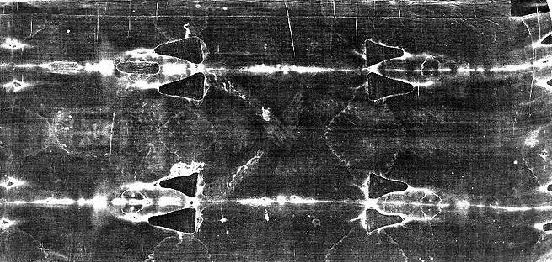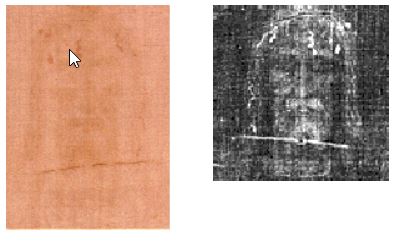© 2000 Ken Glasziou
© 2000 The Brotherhood of Man Library
| Jesus explained that he had purposely ignored the great men of Earth | Volume 7 - No. 4 — Index | At Caesarea-Phillipi |
The best known of all Christian relics, the Shroud of Turin is a burial shroud that carries the faintest negative image of a crucified male whose body bears all the marks, wounds, contusions and blood stains consistent with the records we have of Jesus’ scourging and crucifixion of almost two thousand years ago.
Always well known in Christian circles, the shroud attained notoriety when it was subjected to the then new technology of photography for the first time in 1899. To the amazement of the photographer, when he developed his photographic negative what confronted him was not a faint obscure image but the equivalent of a photographic positive with a clear and detailed image of a bearded male who had been crucified.
Detailed studies of this image provided highly convincing evidence of its authenticity as the burial cloth in which the hastily embalmed body of Jesus would probably have been wrapped by Joseph of Arimathea and Nicodemus, the two men who carried the body to the tomb.
The cloth covered the whole body, having first been laid underneath it, then brought over the head and down to cover the feet. Most of the image is a faint reddish yellow but on the head, arms and feet are deep red stains consistent with being blood stains originating from the crown of thorns and the nails driven through the wrists and feet during crucifixion. These blood stains have been analyzed in minute detail to check whether the were fakes or whether the angles of flow of blood on the head arms and feet was consistent with the position of a body nailed to a cross during crucifixion. Also medical examination indicated the blood flow from the wound in the figure’s side was consistent with expectations if the spear thrust had been made following death.
The image also has a multitude of marks on both front and back that are consistent with the person having been severely scourged prior to crucifixion.
Anybody who examined the detailed evidence accumulated over the years that followed would surely have been justified to conclude that if this was not the burial shroud of Jesus then surely it ought to have been.
The body blow to believers came when, in 1989, samples of cloth from the shroud were examined by three independent carbon-14 dating laboratories who jointly declared the cloth to date at about 1350 AD–along with an announcement by one of the scientists involved that the odds against them being wrong were a thousand trillion to one.
Naturally there followed a spate of books denouncing the shroud as an artist’s fake. But there were also counter arguments that were just as adamant that there was no possibility of this shroud image being faked in the manner described or by the particular technique proposed.
One of the most vociferous of those crying fake claimed the image was a simple iron oxide painting using techniques that were well known in the middle ages. For anyone acquainted with the detail of the image, the proposal appears too simplistic. It also fails to account for figures from spectral analysis showing there is not enough iron in the image areas to account for the intensity of the color.
However, despite all the if’s and but’s, the carbon dating appeared to dismiss the possibility that the shroud dates back to the time of Jesus.
Real doubts on the conclusiveness of the carbon dating perhaps began when information leaked out that the carbon dating of an Egyptian mummy from Manchester Museum had given the peculiar result that the bandages around the mummy body had been dated to be about 1000 years younger than the body. This leakage appears to have generated a spate of conflicting information that has come from other carbon datings.
For example, in 1984 samples of a well preserved body from a peat bog in Cheshire, England, had been sent to three well accredited laboratories with results coming back as 3rd century BC, first century AD, and fifth century AD!!
In 1989 a test was devised by Britain’s Science and Engineering Council for inter-comparison of 38 carbon-dating laboratories, all given material from the same sample. Results were considered satisfactory for only seven of these. Among those faring badly were laboratories that used the then new accelerator mass spectrometer methodology as employed for dating of the Turin shroud.
Perhaps the strongest grounds for criticism of the carbon dating of the shroud came from an investigator who had prior experience with Mayan carvings that were initially considered to be fakes. This was because of the presence of a hard, varnish-like coating. However, the coating actually turned out to be a natural, biologically-derived coat caused by the activities of bacteria and fungi.
This investigator, Dr Garza-Valdes, later had the opportunity to examine under the microscope, small pieces of the shroud material that had been cut out for the carbon dating work. He immediately recognized the apparent presence of similar biologically derived contamination on the shroud fibers. Given this information, the carbon-dating people stated how they had cleaned the samples with acid and alkali but further tests using their technique demonstrated the contamination remained.
Garza-Valdes then arranged for further examination of the blood stains including DNA analysis using standard techniques. These are stated to show that the blood on the shroud is from a human male.
The catch with this work is that it was not officially authorized and is not recognized by the Vatican on the grounds that they are not in a position to guarantee that the samples were genuine.
However, the Garza-Valdes work appears to have gained peer group acceptance, and most probably consists in authentic findings. Opinion appears to be that the carbon dating work must now be re-done.
Whatever the results of new tests, problems will remain. Several scientists from nuclear establishments have pointed out that the biblical version of the resurrection claims the physical body of Jesus simply disappeared. Thus, those who accept that this was a supernatural event are quite right to claim that carbon dating cannot give conclusive proof. For example, there is a distinct possibility of conversion of carbon 13 to carbon 14 via neutron bombardment reactions that could feasibly have occurred during a supernatural dissolution of a material body.
So what does the Urantia Book say? Joseph of Aramathea and Nicodemus, both wealthy and influential Jews, went to Pilate with a large sum of money in order to get Pilate’s permission to remove the body. The normal practice was that the bodies of such victims of crucifixion were left to be disposed of by wild animals. Pilate, to his credit, refused the money, but did give them written authority to do as they would with the body of Jesus.
As the two went to retrieve it, they took with them a large quantity of myrrh and aloes, cloths to be soaked with these embalming agents, and one or two large linen sheets. Obviously they were well prepared for the task, hence knew they would later have to carry the body, probably by themselves, to Joseph’s new family tomb nearby. It appears likely that they must have had a stretcher-type of carrying device.
At Golgotha, they wrapped the body of Jesus in one of the large linen sheets. The disciple John and the Roman centurion then helped them carry the body. Limp bodies are notoriously difficult to carry and they also had the embalming ointments so the fact that four men were involved tends to support the use of a stretcher-like carrying device.
Once at the tomb, Joseph and Nicodemus wrapped the body in cloths saturated with the embalming ointments, after which they wrapped it in a linen sheet and placed it reverently on a shelf. The account reads as if this was a second linen sheet but it may not have been. If there were two sheets, the one used in carrying the body to the tomb would be the only one that could have the markings that are on the Turin shroud–the marks from scourging, etc. This is because the second sheet was wrapped over the top of the embalming cloths soaked in myrrh and aloes, hence would not directly contact the body.
If there were two sheets, possibly the first sheet would have been taken back to his home by Joseph of Arimathea, along with the stretcher and vessels used for the embalming fluids. If so, Joseph and his family were its initial custodians. The Urantia Papers inform us that permission to dispose of the body of Jesus was granted to superhuman beings present at the tomb site:
“The mortal remains of Jesus underwent the same natural process of elemental disintegration as characterizes all human bodies on earth except that, in point of time, this natural mode of dissolution was greatly accelerated, hastened to that point where it became well-nigh instantaneous.” (UB 189:2.8)
It appears highly unlikely that any natural laws of physics were suspended during this flash dissolution of the material body of Jesus. Thus, enormous heat would have been generated. Perhaps that is why the body was taken outside of the tomb for dissolution.
Apparently the grave cloths were first removed. We are told that when Mary, and later Peter, went to the tomb, the napkin where Jesus’ head had rested and the bandages were still in the tomb while the “covering sheet lay at the foot of the burial niche.” (UB 189:4.6)
¶ Conclusions
At the very least the Turin shroud corrects the impression that Jesus was a blue-eyed male Caucasian. He was a Semite. It also vividly reminds us of the pain and indignities that he actually suffered.
Despite the carbon dating debacle, it still appears to be possible that the Turin shroud is the actual sheet used by Joseph and Nicodemus during transport of Jesus’ body to the tomb. One other possibility is that it is a sheet in which the original was routinely wrapped for storage, and the markings and blood stains have been transferred to it from the original. This may have occurred during one of the many disasters suffered by the original which are known to have included both fire and dousing with water.
¶ References
- Wilson, Ian. “The Blood and the Shroud.” (Weidenfeld and Nicolson, 1998)
¶ Images


¶ External links
| Jesus explained that he had purposely ignored the great men of Earth | Volume 7 - No. 4 — Index | At Caesarea-Phillipi |